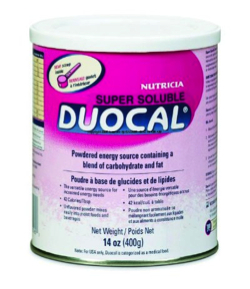Maintaining a High-Calorie Diet for Special Needs Kids

This post may contain affiliate links; please see our terms of use for details.
Fat Free! 0 Calories! Sugar free! Diet friendly!
Our society is obsessed with dieting and losing weight. Walk the aisles of the grocery store and everything is fat free, sugar free and calorie free.
But for many of us with children with disabilities, we think of diet in a different way. Our kids may be on a high calorie diet.
And our low-fat, zero-calorie obsessed grocery store isn’t really helpful! I don’t want fat free yogurt… I’m looking for FULL fat yogurt! (Yeah, good luck with that.)
My son has been on a high calorie diet for three years now and we’ve come up with some ways to increase his calorie intake without having to shop at multiple speciality grocery and health food stores.
Here are some tips to developing a high calorie diet:
Add Calories with Duocal or PediaSure
First off, talk to your doctor about adding Duocal to your child’s food. Duocal is essentially just powdered calories. Every tablespoon contains 42 calories and it’s super soluble, so it dissolves in just about anything. We put it in Ivan’s juice, yogurt, spaghetti sauce, cereal milk… whatever he’s eating really. It’s tasteless and adds very little texture to foods.
 Talk to your doctor about how many calories you should add through Duocal a day (we add about 100 Duocal calories daily). Obviously Duocal isn’t going to add any nutrition, just calories, so most of your child’s calories should come from food if possible.
Talk to your doctor about how many calories you should add through Duocal a day (we add about 100 Duocal calories daily). Obviously Duocal isn’t going to add any nutrition, just calories, so most of your child’s calories should come from food if possible.
PediaSure, on the other hand, does add both calories and some nutrition too. Many doctors will recommend kids drink PediaSure throughout the day (how many bottles depends on your child’s needs). It’s essentially a sugary and sweet milkshake and comes in many different flavors, which means you’ll want to watch sugar intake, but also means that many kids really love it (so it’s easy to give to them). My son likes to be different so of course he’s not a big milkshake fan, so PediaSure has never worked for us.
PediaSure and Duocal are both available over the counter (PediaSure is sold at most grocery stores and Duocal can be purchased online), but if you’ll be using either or both daily ask your doctor for a prescription and see if your insurance will cover the cost. You can save a lot of money that way!
Look for the Highest Calorie Options
When you’re calorie counting you get used to reading the nutritional information. A lot. And you get good at comparison shopping. So when you’re buying your regular fare (bread, milk, yogurt, etc) look for the products with the highest calories.
This may mean trying out a few grocery stores in your area until you settle on one that carries the best high-calorie choices (I’m not a fan of shopping at multiple stores multiple times a week). Dry goods can also be ordered in bulk from places like Amazon, so if there is a particular brand of cereal, for example, that your child likes and is high in calories it might make sense to have that delivered in bulk.
But speaking of yogurt, we’ve found a tasty and super high calorie yogurt that Ivan just loves! Noosa is a whole milk high calorie yogurt that is delicious, has over 200 calories per serving, and best yet is easy to find. Even our Target carries Noosa yogurts.
Add Calorie Enhancers
Cooking high calorie meals for one member of the family while making regular (or even low) calorie meals for everyone else isn’t always fun. One way to avoid having to make completely different meals for everyone is to add calorie enhancers to your child’s serving. Calorie enhancers can be extra sour cream or cheese with their burrito, extra butter on their toast or maybe some heavy cream mixed in with their cereal.
Below is a table with possible calorie enhancer ideas. Our goal for Ivan is to add 300 to 400 calories from this table every day. A lot of these enhancers also add extra nutrition to your child’s diet. Flaxseeds, for example, are high in calcium and iron, molasses is incredibly high in iron (who knew?) and avocados are high in vitamin C.
| Calories per Tablespoon in Calorie Enhancers | |
|---|---|
| 115 | Granola |
| 110 | Vegetable Oil |
| 100 | Butter/Margarine |
| 100 | Mayonaise |
| 65 | Sweetened Condensed Milk |
| 60 | Corn Syrup |
| 55 | Coconut Cream |
| 52 | Jam, Jelly, Pancake Syrup |
| 51 | Heavy Cream |
| 50 | Cream Cheese |
| 46 | Molasses |
| 45 | Chocolate Syrup |
| 25 | Evaporated Milk |
| 25 | Flaxseeds |
| 25 | Sour Cream |
| 25 | Wheat Germ |
| 17 | Hummus or Bean Spread |
| 16 | Avocado |
| 15 | Powdered Milk |
Don’t Forget the Fiber!
One last tip… when starting a high calorie diet, don’t forget the fiber! It’s easy to switch to high calorie bread or high calorie cereals and lose sight of the fiber that’s being lost (potato bread, for example, is much higher in calories than whole wheat bread, but includes almost no fiber). Plus, high calorie diets tend to be higher in fat and fatty diets without the right amount of fiber can lead to constipation.
Your bread should contain about 3 to 5 grams of fiber per serving; cereal should provide at least 3 grams of fiber per serving. Whole grain pasta has about double the fiber (but less calories). Brown rice is a winner with both more fiber and more calories than white rice.
If your child is still having trouble with constipation on a high calorie diet, you can also consider adding a dietary fiber supplement, like Benefiber.
Read those labels and become familiar with nutrition facts. After some trial and error you should be able to create a balanced diet for your child that provides the nutrition he needs plus those higher calories. Now… will he eat it??? That’s a separate topic!

Related Posts

Health & Nutrition
Making Medicine Manageable: Teaching Kids To Swallow Pills
Teaching your child how to swallow a pill is an important skill as they grow older. Find out how to do it here.

Feeding and Eating, Special Needs
Feeding Therapy Approaches for Infants with Special Needs
Many children with special needs have feeding difficulties. Working with a speech therapist, being patient, and experimenting with textures can help.

Health & Nutrition
5 Tips for Managing Spring Allergies in Kids
Spring allergies can cause uncomfortable symptoms. The best way to navigate allergies in kids is to identify triggers and avoid exposure.